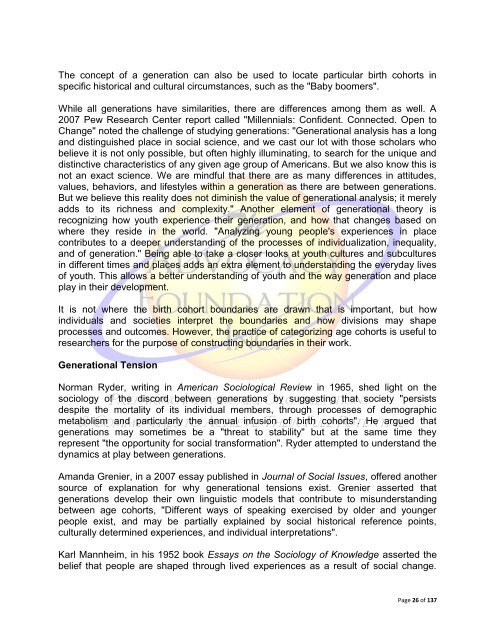Generational Progression
Generational Progression
Generational Progression
Create successful ePaper yourself
Turn your PDF publications into a flip-book with our unique Google optimized e-Paper software.
The concept of a generation can also be used to locate particular birth cohorts in<br />
specific historical and cultural circumstances, such as the "Baby boomers".<br />
While all generations have similarities, there are differences among them as well. A<br />
2007 Pew Research Center report called "Millennials: Confident. Connected. Open to<br />
Change" noted the challenge of studying generations: "<strong>Generational</strong> analysis has a long<br />
and distinguished place in social science, and we cast our lot with those scholars who<br />
believe it is not only possible, but often highly illuminating, to search for the unique and<br />
distinctive characteristics of any given age group of Americans. But we also know this is<br />
not an exact science. We are mindful that there are as many differences in attitudes,<br />
values, behaviors, and lifestyles within a generation as there are between generations.<br />
But we believe this reality does not diminish the value of generational analysis; it merely<br />
adds to its richness and complexity." Another element of generational theory is<br />
recognizing how youth experience their generation, and how that changes based on<br />
where they reside in the world. "Analyzing young people's experiences in place<br />
contributes to a deeper understanding of the processes of individualization, inequality,<br />
and of generation." Being able to take a closer looks at youth cultures and subcultures<br />
in different times and places adds an extra element to understanding the everyday lives<br />
of youth. This allows a better understanding of youth and the way generation and place<br />
play in their development.<br />
It is not where the birth cohort boundaries are drawn that is important, but how<br />
individuals and societies interpret the boundaries and how divisions may shape<br />
processes and outcomes. However, the practice of categorizing age cohorts is useful to<br />
researchers for the purpose of constructing boundaries in their work.<br />
<strong>Generational</strong> Tension<br />
Norman Ryder, writing in American Sociological Review in 1965, shed light on the<br />
sociology of the discord between generations by suggesting that society "persists<br />
despite the mortality of its individual members, through processes of demographic<br />
metabolism and particularly the annual infusion of birth cohorts". He argued that<br />
generations may sometimes be a "threat to stability" but at the same time they<br />
represent "the opportunity for social transformation". Ryder attempted to understand the<br />
dynamics at play between generations.<br />
Amanda Grenier, in a 2007 essay published in Journal of Social Issues, offered another<br />
source of explanation for why generational tensions exist. Grenier asserted that<br />
generations develop their own linguistic models that contribute to misunderstanding<br />
between age cohorts, "Different ways of speaking exercised by older and younger<br />
people exist, and may be partially explained by social historical reference points,<br />
culturally determined experiences, and individual interpretations".<br />
Karl Mannheim, in his 1952 book Essays on the Sociology of Knowledge asserted the<br />
belief that people are shaped through lived experiences as a result of social change.<br />
Page 26 of 137

















